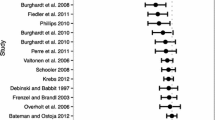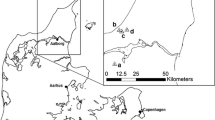Abstract
Lepidoptera play an important role in terrestrial ecosystems as pollinators, as components of the food chain and as indicators for healthy ecosystems due to their sensitivity to change. Heterogeneous landscapes with variability of topographical features, vegetation structure combined with food sources for all life stages are the basis for successful lepidopteran oviposition. A multiple-scale analysis is proposed to understand the hierarchical relationships between selected site to plant characteristics and oviposition preferences for the dingy skipper (Erynnis tages). To achieve this goal, factors driving oviposition at the plant and patch scale were identified and scale dependencies at the site scale were assessed. At the plant scale, tallest host plants were used for oviposition; however relative egg height upon each plant was similar in both host plant species [bird’s-foot trefoil (Lotus corniculatus) and horseshoe vetch (Hippocrepis comosa)]. The main factors preferred by E. tages in L. corniculatus patches were sward height and percent of bare ground, and in H. comosa host plant density patches. Selected patches had slopes of greater gradients (mostly facing south) than patches with no selected host plants. At the site scale, oviposition patches were clustered at small scales and oviposition sites were dispersed at larger scales. Our study suggests that oviposition selection in E. tages is a hierarchical process varying from the site to the plant scale. Our study provides empirical evidence useful to inform landscape management strategies. These can be expanded to assess larger scale vegetation and habitat suitability beyond individual sites for systematic conservation planning.

Similar content being viewed by others
References
Asher J, Warren M, Fox R, Harding P, Jeffcoate G, Jeffcoate S (2001) The millennium atlas of butterflies in Britain and Ireland. Oxford University Press, New York
Bergström A (2005) Oviposition sites preferences of the threatened butterfly Panassius mnemosyne—implications for conservation. J Insect Conserv 9:21–27. doi:10.1007/s10841-004-3204-4
Blair RB, Launer AE (1997) Butterfly diversity and human land use: species assemblages along an urban gradient. Biol Conserv 80:113–125. doi:10.1016/S0006-3207(96)00056-0
Bowers MA, Dooley JL (1999) A controlled, hierarchical study of habitat fragmentation: responses at the individual, patch and landscape scale. Landscape Ecol 14:381–389. doi:10.1023/A:1008014426117
Cabeza M, Arponen A, Jäättelä L, Kujala H, van Teeffelen A, Hanski I (2010) Conservation planning with insects at three different spatial scales. Ecography 33:54–63. doi:10.1111/j.1600-0587.2009.06040.x
Cesa A, Paruelo JM (2011) Changes in vegetation structure induced by domestic grazing in Patagonia (Southern Argentina). J Arid Environ 75:1129–1135. doi:10.1016/j.jaridenv.2011.04.003
Cooper SM, Perotto-Baldivieso HL, Owens MK, Meek MG, Figueroa-Pagán M (2008) Distribution and interaction of white-tailed deer and cattle in a semi-arid grazing system. Agr Ecosyst Environ 127:85–92. doi:10.1016/j.agee.2008.03.004
Cowley MJR, Thomas CD, Wilson RJ, Léon-Cortés JL, Gutiérrez D, Bulman CR (2001) Density-distribution relationships in British butterflies. II. An assessment of mechanisms. J Anim Ecol 70:426–441. doi:10.1046/j.1365-2656.2001.00509.x
Dennis RHL, Shreeve TG, Van Dyck H (2003) Towards a functional resource-based concept for habitat: a butterfly viewpoint. Oikos 102:417–426
Didham RK, Ghazoul J, Stork NE, Davis A (1996) Insects in fragmented forests: a functional approach. Trends Ecol Evol 11:255–260. doi:10.1016/0169-5347(96)20047-3
Erhardt A, Thomas JA (1991) Lepidoptera as indicators of change in the semi-natural grasslands of lowland and upland Europe. In: Collins NM, Thomas JA (eds) The conservation of insects and their habitats. Academic Press, London, pp 213–236
Espírito-Santo MM, Neves F, Andrad-Neto FR, Fernandes GW (2007) Plant architecture and meristem dynamics as the mechanisms determining the diversity of gall-inducing insects. Oecologia 153:353–364. doi:10.1007/s00442-007-0737-8
Feagin R, Wu XB (2007) The spatial patterns of functional groups and successional direction in a coastal dune community. Rangeland Ecol Manag 60:417–425. doi:10.2111/1551-5028(2007)60
Fox R, Warren MS, Asher J, Brereton TM, Roy DB (2007) The state of Britain’s butterflies 2007. Butterfly Conservation, Wareham
Fox R, Warren MS, Brereton TM, Roy DB, Robinson A (2011) A new Red List of British butterflies. Insect Conserv Diver 4:159–172. doi:10.1111/j.1752-4598.2010.00117.x
Goulson D, Lepais O, O’Connor S, Osborne JL, Sanderson RA, Cussans J, Goffe L, Darvil B (2010) Effects of land use at a landscape scale on bumblebee nest density and survival. J Appl Ecol 47:1207–1215. doi:10.1111/j.1365-2664.2010.01872.x
Gutiérrez D, Menéndez R (1995) Distribution and abundance of butterflies in a mountain area in the northern Iberian peninsula. Ecography 18:209–216. doi:10.1111/j.1600-0587.1995.tb00123.x
Gutiérrez D, Thomas CD, Léon-Cortés JL (1999) Dispersal, distribution, patch network and metapopulation dynamics of the dingy skipper butterfly (Erynnis tages). Oecologia 121:506–517. doi:10.1007/s004420050957
Haase P (1995) Spatial pattern analysis in ecology based on Ripley’s K-function: introduction and methods of edge correction. J Veg Sci 6:575–582. doi:10.2307/3236356
Jäschke A, Kolligs D (2009) Oviposition habitat and feeding behaviour of the dingy skipper (Erynnis tages (Linnaeus, 1758)), in Schleswig-Holstein (North Germany) (Hesperiidae). Nota Lepid 32:27–37
Lancaster J, Downes BJ, Arnold A (2010) Environmental constraints on oviposition limit egg supply of a stream insect at multiple scales. Oecologia 163:373–384. doi:10.1007/s00442-010-1565-9
Lawton JH (1983) Plant architecture and the diversity of phytophagous insects. Annu Rev Entomol 28:23–29. doi:10.1146/annurev.en.28.010183.000323
Marquis RJ, Lill JT, Piccinni A (2002) Effect of plant architecture on colonization and damage by leaftying caterpillars of Quercus alba. Oikos 99:531–537. doi:10.1034/j.1600-0706.2002.11897.x
Mattingly WB, Flory SL (2011) Plant architecture effects periodical cicada oviposition behaviour on native and non-native hosts. Oikos 120:1083–1091. doi:10.1111/j.1600-0706.2010.18994.x
Meiners T, Obermaier E (2004) Hide and seek on two spatial scales–vegetation structure effects herbivore oviposition and egg parasitism. Basic Appl Ecol 5:87–94. doi:10.1078/1439-1791-00182
Mouissie AM, Apol MEF, Heil GW, van Diggelen R (2008) Creation and preservation of vegetation patterns by grazing. Ecol Model 218:60–72. doi:10.1016/j.ecolmodel.2008.06.018
Obermaier E, Heisswolf A, Randlkofer B, Meiners T (2006) Enemies in low places-insects avoid winter mortality and egg parasitism by modulating oviposition height. B Entomol Res 96:337–343. doi:10.1079/BER2006431
Obermaier E, Heisswolf A, Poethke HJ, Randlkofer B, Meiners T (2008) Plant architecture and vegetation structure: two ways for insect herbivores to escape parasitism. Eur J Entomol 105:233–240
O’Neill RR, Johnson AR, King AW (1989) A hierarchical framework for the analysis of scale. Landscape Ecol 3:193–205. doi:10.1007/BF00131538
Perotto-Baldivieso HL, Meléndez-Ackerman E, García MA, Leimgruber P, Cooper SM, Martinez A, Calle P, Ramos Gonzales OM, Quiñones M, Christen C, Pons G (2009) Spatial distribution, connectivity, and the influence of scale: habitat availability for the endangered Mona Island rock iguana. Biodivers Conserv 18:905–917. doi:10.1007/s10531-008-9520-3
Raghu S, Drew RAI, Clarke AR (2004) Influence of host plant structure and microclimate on the abundance and behaviour of a tephritid fly. J Insect Behav 17:179–190. doi:10.1023/B:JOIR.0000028568.90719.2a
Rákosy L, Schmitt T (2011) Are butterflies and moths suitable ecological indicator systems for restoration measures of semi-natural calcareous grassland habitats? Ecol Indic 11:1040–1045. doi:10.1016/j.ecolind.2010.10.010
Randlkofer B, Obermaier E, Hilker M, Meiners T (2010) Vegetation complexity—the influence of plant species diversity and plant structures on plant chemical complexity and arthropods. Basic Appl Ecol 11:383–395. doi:10.1016/j.baae.2010.03.003
Renwick JAA, Chew FS (1994) Oviposition behaviour in Lepidoptera. Annu Rev Entomol 39:377–400
Ripley BD (1976) The second-order analysis of stationary processes. J Appl Probab 13:255–266
Rudgers JA, Whitney JD (2006) Interactions between insect herbivores and a plant architectural dimorphism. J Ecol 94:1249–1260. doi:10.1111/j.1365-2745.2006.01161.x
Sarin C, Bergman K (2010) Habitat utilisation of burnet moths (Zygaena spp.) in southern Sweden: a multi-scale and multi-stage perspective. Insect Conserv Diver 3:180–193. doi:10.1111/j.1752-4598.2010.00084.x
Shreeve TG, Dennis RLH (2011) Landscape scale conservation: resources, behaviour, the matrix and opportunities. J Insect Conserv 15:1–2. doi:10.1007/s10841-010-9336-9
Slater M (2008) Dingy skipper Erynnis tages: Investigation to ascertain the preferred sites for ova deposition on its larval food plant Lotus sp. in Warwickshire on a range of colony sites. Warwickshire Buterflies. p 44
Steffan-Dewenter I, Tscharntke T (2002) Insect communities and biotic interactions on fragmented calcareous grasslands—a mini review. Biol Conserv 104:275–284. doi:10.1016/S0006-3207(01)00192-6
Thomas JA, Thomas CD, Simcox DJ, Clarke RT (1986) Ecology and declining status of the silver-spotted skipper butterfly (Hesperia comma) in Britain. J Appl Ecol 23:365–380
Urban DL, O’Neill RV, Shugart HH (1987) A hierarchical perspective can help scientists understand spatial patterns. Landscape Ecol 37:119–127. doi:10.1007/BF00124376
van Swaay CAM (2002) The importance of calcareous grassland for butterflies in Europe. Biol Conserv 104:315–318. doi:10.1016/S0006-3207(01)00196-3
Verdú JR, Numa C, Hernández-Cuba O (2011) The influence of landscape structure on ants and dung beetles diversity in a Mediterranean savanna—Forest ecosystem. Ecol Indic 11:831–839. doi:10.1016/j.ecolind.2010.10.011
Warren MS (1985) The influence of shade on butterfly numbers in woodland rides, with special reference to the wood white Leptidea sinapsis. Biol Conserv 33:147–164. doi:10.1016/0006-3207(85)90101-6
Woodcock BA, Potts SG, Westbury DB, Ramsay AJ, Lambert M, Harris SJ, Brown VK (2007) The importance of sward architectural complexity in structuring predatory and phytophagous invertebrate assemblages. Ecol Entomol 32:302–311. doi:10.1111/j.1365-2311.2007.00869.x
Yang LH (2006) Periodical cicadas use light for oviposition site selection. P Roy Soc B-Biol Sci 273:2993–3000. doi:10.1098/rspb.2006.3676
Acknowledgments
We would like to thank Colin Lucas for his guidance and hard work. We are also grateful to the Bedfordshire Wildlife Trust and National Trust for permission to access Totternhoe Knolls and Quarry nature reserve and for providing the necessary support for this research. Andrew B. Gill, Monica Rivas Casado, Chris Damant and the 2 anonymous reviewers provided very useful comments that helped significantly improve this manuscript.
Author information
Authors and Affiliations
Corresponding author
Rights and permissions
About this article
Cite this article
Dickins, E.L., Yallop, A.R. & Perotto-Baldivieso, H.L. A multiple-scale analysis of host plant selection in Lepidoptera. J Insect Conserv 17, 933–939 (2013). https://doi.org/10.1007/s10841-013-9574-8
Received:
Accepted:
Published:
Issue Date:
DOI: https://doi.org/10.1007/s10841-013-9574-8




